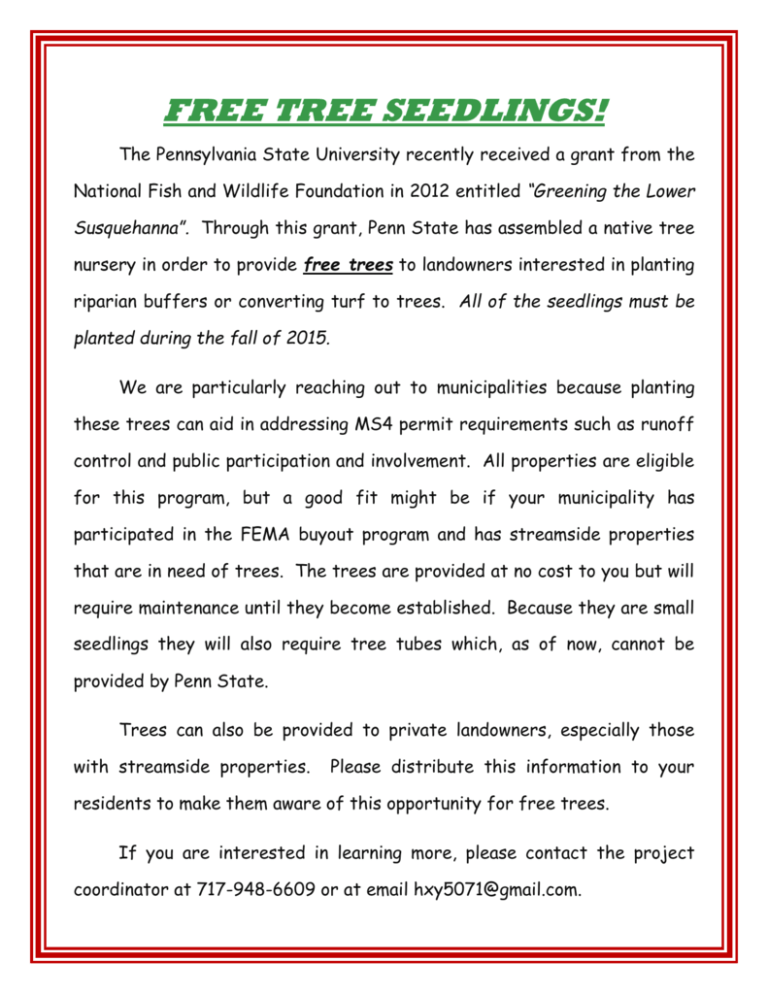
Trees will be planted for multiple use management purposes and may be subject to harvesting at the appropriate time. Trees will not be individually identified we do not plant a specific tree in memory of an individual. The Forest Service will take care of the trees as part of their normal reforestation activities. The contributed funds are used exclusively for acquiring seedlings and to cover the cost of planting trees. For this amount, we can usually plant between approximately 10 seedlings, generally conifers. The suggested minimum donation is $ 10.00. According to the Internal Revenue Service, contributions to this program qualify as charitable deductions under section 170(c) (1) of the Internal Revenue Service code.

The purpose is to allow individuals or groups to voluntary contribute funds directly to the Forest Service for tree planting on National Forests as a positive and personal step toward improving the environment. Shelterbelts often increase crop yields and enhance land value.The USDA Forest Service Plant-A-Tree Program was established in 1983. Field and livestock shelterbelts provide protection for soil, young seedlings, crops, livestock and can be used as cover for wildlife. Windbreaks/Shelterbelt, when planted around homes, provide protection from the hot, dry winds of summer and relief from winter winds and snow. More information is available about seedling replanting and cultivation in 2023.Ī preliminary species list for the Hermit’s Peak/Calf Canyon burn scar area is also available. New Mexico Forestry Divsion collaborates with New Mexico Highlands University and New Mexico State at the New Mexico Reforestation Center in Mora, NM. Post-Fire Restoration helps to begin tree recovery in burn scar areas affected by wildland fire. Many of the species offered by the program provide and/or improve habitat for wildlife. Other species provided by the program may offer restoration to waterways and minimize surface runoff, which in turn reduces soil erosion. Forested or re-forested lands offer numerous benefits such as aesthetics and recreational value. Reforestation projects are important in restoring the affected areas back to their original state or improved state. For questions about prices and minimum order size refer to ordering information.

And as an added bonus, the weather is better for planting! Select your shipping or pickup date so that you can plant your seedlings five to six weeks before your area of the state starts having hard freeze days. Fall is a highly successful time to plant containerized seedlings because the plants have time to establish roots over the winter while dormant and before putting on top growth in the spring. Please note all containerized species are offered in the fall and bare root species (when available) and containerized species are offered in the spring. Ordering for the fall season begins the first Monday of July (if that day happens to be a state holiday then it starts the next day) and continues through the first week of October with distribution beginning in mid-September and ending in mid-October. Ordering for the spring season always begins on the first Monday of December and continues through the middle of April with distribution beginning early March and ending in late April. Seedlings are sold in small containers, large containers, and/or bare root. Not all species are available in all types. Large containers and bare root are more limited in the species available. Further, seedlings can be used for reforestation projects after catastrophic wildfire and/or tree mortality due to insect and disease epidemics.įorestry offers more than sixty different species for sale in two separate events in the fall and spring.

Trees are also important to help with climate change mitigation: they store carbon, provide cooling shade, and help with water infiltration. The program was started in the 1960s and since then, millions of trees have been planted throughout New Mexico. The Forestry Division offers low-cost seedlings to landowners to plant for reforestation, erosion control, windbreaks, streambank restoration, and wildlife habitat improvement. Please note that due to one of our growers being closed for infrastructure assessment we don’t have bareroot or large container seedlings available for this spring. Distribution will be mid-March through late April. Ordering is first come first serve, so order early for the best selection.

Ordering for our Spring season begins Decemand ends on April 21, 2023. We will have more inventory for some species then including more Arizona cypress and Afghanistan pine. NOTICE: We are sold out of all species except Aspen, Arizona cypress, and Afghanistan pine.


 0 kommentar(er)
0 kommentar(er)
